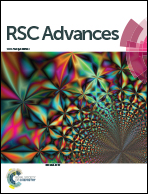Facile synthesis of CuS mesostructures with high photothermal conversion efficiency
Abstract
Photothermal ablation (PTA) therapy has received much attention during the past few years as a minimally invasive alternative to conventional therapeutic approaches. Among others, the semiconductor copper sulfide (CuS) is a developing and promising photothermal agent for potential cancer therapy. In the present work, CuS mesostructures with high photothermal conversion efficiency have been synthesized by assembling CuS nanoparticles with opposite charges in the aqueous phase via electrostatic interaction and then calcination at elevated temperature. Specifically, 3-mercaptopropionic acid (MPA)- and 3-mercaptopropylamine (MPa)-capping CuS nanoparticles were synthesized respectively as oppositely charged precursors, which were then assembled and calcinated to produce CuS mesostructures. The resultant CuS mesostructures have well-ordered honeycomb-like structures with high specific surface area, and can be readily heated by a 980 nm laser and are capable of killing cancer cells efficiently by the photothermal effect.


 Please wait while we load your content...
Please wait while we load your content...